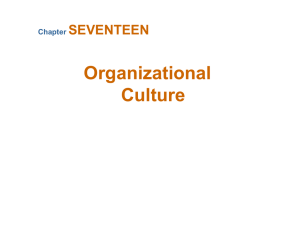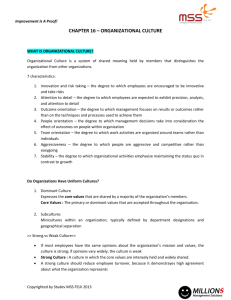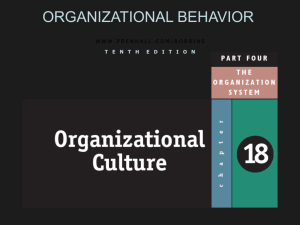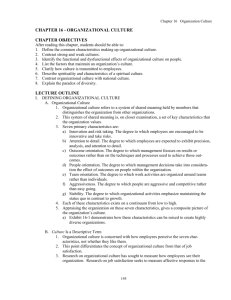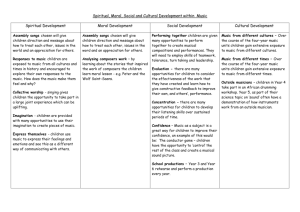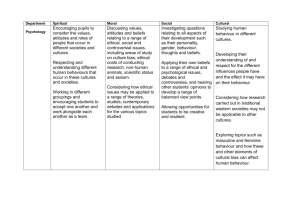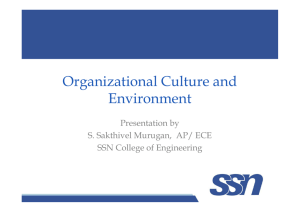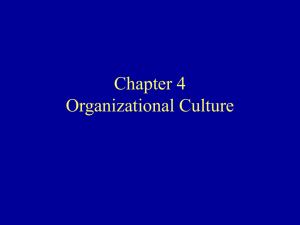Organizational Culture Chapter 14
advertisement
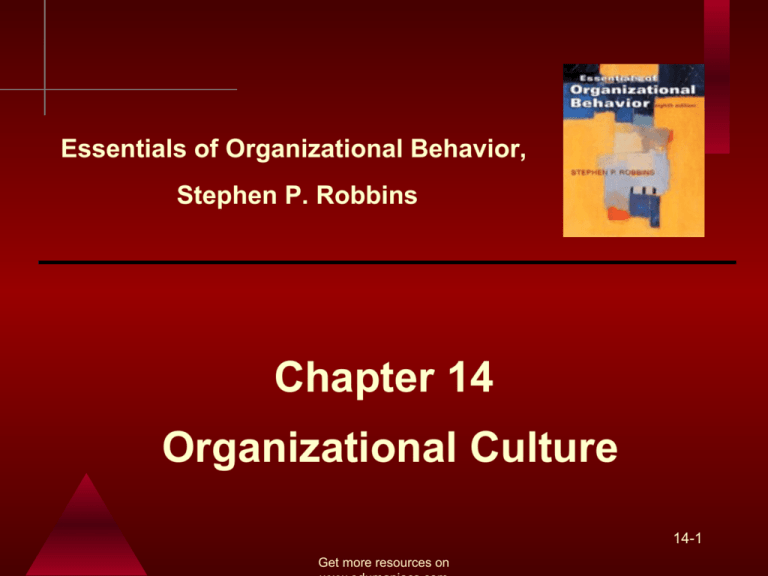
Essentials of Organizational Behavior, Stephen P. Robbins Chapter 14 Organizational Culture 14-1 Get more resources on After reading this chapter, you should be able to: 1) Define the common characteristics making up organizational culture 2) Contrast strong and weak cultures 3) Identify the functional and dysfunctional effects of organizational culture on people 4) List the factors that maintain an organization’s culture 14-2 Get more resources on After reading this chapter, you should be able to: 5) Clarify how culture is transmitted to employees 6) Characterize a customerresponsive culture 7) Describe spirituality and characteristics of a spiritual culture 8) Contrast organizational culture with national culture 9) Explain the paradox of diversity 14-3 Get more resources on Organizational culture • Set of key characteristics that the organization values that distinguishes the organization from other organizations 14-4 Get more resources on Stability Innovation and risk taking Attention to Detail Characteristics of Organizational Culture Outcome Orientation Team Orientation People Orientation 14-5 Get more resources on • Organizational culture is concerned with how employees perceive the seven characteristics, not whether they like them 14-6 Get more resources on Do Organizations Have Uniform Cultures? • A dominant culture expresses the core values that are shared by a majority of the organization’s members 14-7 Get more resources on Do Organizations Have Uniform Cultures? • Subcultures tend to develop in large organizations to reflect common problems, situations, or experiences that members face 14-8 Get more resources on • A strong culture is characterized by the organization’s core values being both intensely held and widely shared • A weak culture is characterized by vagueness, ambiguity, and/or inconsistencies 14-9 Get more resources on Culture’s Functions •Boundary-defining role •Conveys a sense of identity •Facilitates the generation of commitment •Enhances social system stability •Sense-making and control mechanism 14-10 Get more resources on Culture as a Liability • Shared values do not agree with organization’s effectiveness • Environment is dynamic • Entrenched culture in rapid change • Hinders ability to respond to changes 14-11 Get more resources on How a Culture Begins • Ultimate source of an organization’s culture is its founders 14-12 Get more resources on Keeping a Culture Alive • Selection • Top Management • Socialization 14-13 Get more resources on A Socialization Model 14-14 Get more resources on How Cultures Form 14-15 Get more resources on Stories Language How Employees Learn Culture Rituals Material Symbols 14-16 Get more resources on Managing Cultural Change Cultural change is most likely to take when the following conditions exist • Dramatic crisis exists or is created • Turnover in leadership • Young and small organization • Weak culture 14-17 Get more resources on Creating an Ethical Organizational Culture • Be a visible role model • Communicate ethical expectations • Provide ethical training 14-18 Get more resources on Creating an Ethical Organizational Culture • Visibly reward ethical acts and punish unethical ones • Provide protective mechanisms 14-19 Get more resources on Creating a Customer Responsive Culture • Companies recognize this is the path to customer loyalty and long-term profitability 14-20 Get more resources on Key Variables Shaping CustomerResponsive Cultures • Type of employees • Low formalization • Widespread use of empowerment 14-21 Get more resources on Key Variables Shaping CustomerResponsive Cultures • Good listening skills • Role clarity • Employees who exhibit organizational citizenship behavior 14-22 Get more resources on Managerial Action • Selection • Training and socialization • Structural design • Empowerment • Leadership • Performance evaluation • Reward systems 14-23 Get more resources on Workplace Spirituality • Recognizes that people have an inner life that nourishes and is nourished by meaningful work that takes place in the context of community 14-24 Get more resources on Characteristics of Spiritual Organizations • Strong sense of purpose • Focus on individual development 14-25 Get more resources on Characteristics of Spiritual Organizations • Trust and openness • Employee empowerment • Toleration of employee expression 14-26 Get more resources on Paradox of Diversity • Two Conflicting Goals – Employees accept the organization’s dominant values – Encourage the acceptance of differences 14-27 Get more resources on Paradox of Diversity • Too much investiture may create misfits • Too much divestiture may eliminate unique strengths 14-28 Get more resources on Summary 1) Defined the common characteristics making up organizational culture 2) Contrasted strong and weak cultures 3) Identified the functional and dysfunctional effects of organizational culture on people 4) Listed the factors that maintain an organization’s culture 14-29 Get more resources on Summary 5) Clarified how culture is transmitted to employees 6) Characterized a customerresponsive culture 7) Described spirituality and characteristics of a spiritual culture 8) Contrasted organizational culture with national culture 9) Explained the paradox of diversity 14-30 Get more resources on

